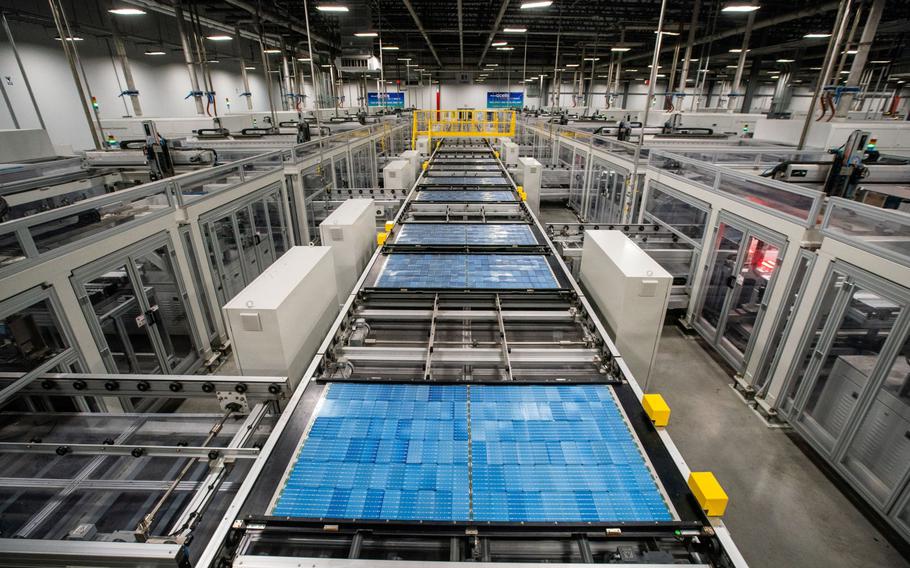
Solar panel cells move along a conveyor prior to lamination and framing at the Hanwha Q Cells manufacturing facility in Dalton, Georgia, on Oct. 6. (Elijah Nouvelage/Bloomberg)
Korean conglomerate Hanwha Solutions pledged to invest more than $2.5 billion in U.S. solar manufacturing, a boost to the Biden administration’s efforts to reduce the nation’s dependence on China for its panel supply.
One of its units, Hanwha Qcells, plans to build a factory in Bartow County, Georgia, to make 3.3 gigawatts of solar ingots, wafers, cells and panels, the company said in a statement Wednesday. It also committed to assembling two gigawatts of modules at its factory site in the northwest part of the state, which is already the biggest panel plant in the Western Hemisphere.
The U.S. is racing to boost domestically made cleantech supplies in its fight against climate change - while also attempting to cut its reliance on imported panels. President Joe Biden’s landmark climate law, the Inflation Reduction Act, which includes generous incentives for solar, battery and electric-vehicle manufacturing, has sparked a wave of new factory announcements.
“Today’s Hanwha Qcells announcement to make the largest solar investment in US history is a big deal for Georgia’s working families and the American economy,” Biden said in a statement. “This investment is a direct result of my economic plan and the Inflation Reduction Act.”
Nonetheless, solar equipment from overseas will be a key part of the U.S. supply chain for years to come. While domestic panel manufacturing has slowly picked up since the Trump administration, China dominates the making of wafers, which are ultra-thin polysilicon squares that are pieced together to make modules.
U.S. dependence on Chinese solar makers has led to occasional slowdowns in the country’s panel installations. In recent years, there have been Covid-related manufacturing delays, trade spats, allegations of forced labor in a region of China and supply snarls at U.S. ports.
“The entire world will be less dependent on tainted Chinese exports,” U.S. Sen. Jon Ossoff, a Georgia Democrat, said at a news conference Wednesday. The project is expected to add 2,500 jobs in the state.
“This is a big deal for the state of Georgia,” he said.
Building the plant in the U.S. will cost more than four times as much as a comparable facility in China, according to BNEF estimates.
Qcells said ground-breaking on the Bartow County facility is expected this quarter. The company’s total module capacity in the U.S. will grow to 8.4 gigawatts by 2024.
“Once the plants go into full operations, the hub will have the biggest fully integrated solar manufacturing facilities in North America,” Hanwha Qcells Chief Executive Officer Justin Lee told reporters during a briefing Wednesday.
Hanwha expects to receive roughly $875 million in tax credits annually under the IRA provisions once the plants go into full operations, according to a statement. On top of that, Hanwha is eligible to receive incentives from the state, including tax cuts as well as discounts on land and construction costs, Lee said.
“We’re going to see a lot more companies like Qcells breaking ground,” John Podesta, senior adviser to the president for clean energy innovation and implementation, said in a briefing with reporters. “The Inflation Reduction Act will create more of those stories.”
Bloomberg’s Josh Saul contributed to this report.